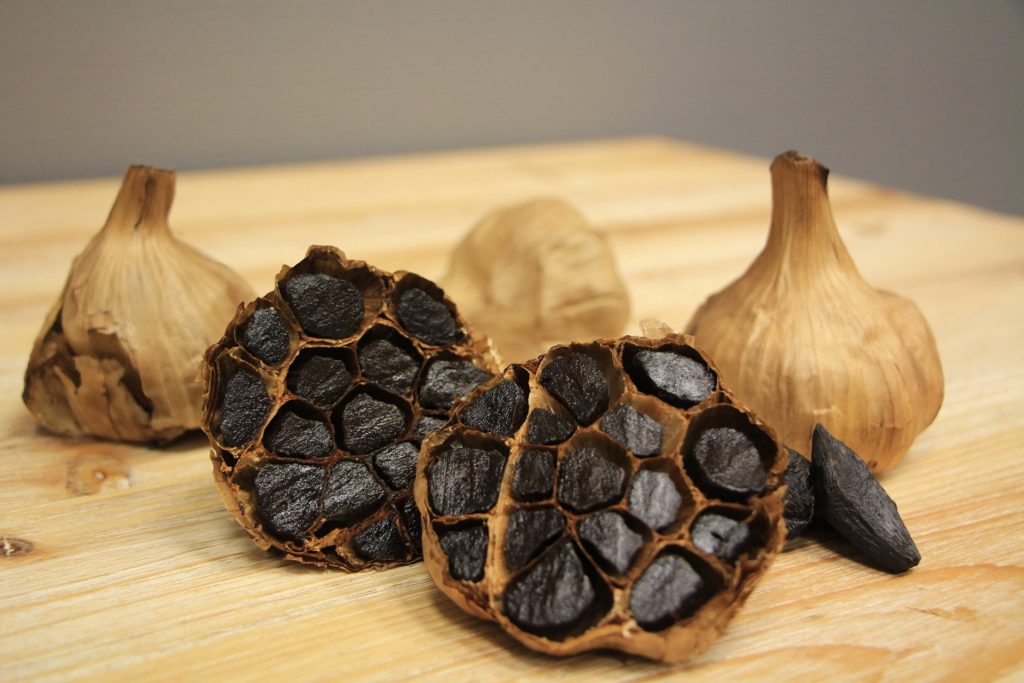These days, black garlic shows up on everything from fine-dining menus to homemade roasted chicken. With its sweet, tangy flavor and softened, darkened cloves, it’s hard to believe black garlic was once a little-known ingredient outside of certain regions in Asia. Below, we’ll explore how black garlic came to be, its cultural significance, and how it eventually became a sought-after staple in global cuisine.
Ancient Roots and Early Usage
Origins in East Asia
Black garlic’s story begins primarily in East Asia, where garlic itself has been cultivated for thousands of years. In places like Korea, China, and Japan, garlic has long been prized for its medicinal properties and as a cooking staple. At some point—likely centuries ago—people discovered that if garlic was stored in warm, humid conditions for extended periods, it would transform into something entirely different.
Folk Remedies and Traditional Beliefs
While the precise origin story for black garlic is murky, many historians speculate that traditional medicine played a role in its early production. Some folk practices believed that black garlic had enhanced health benefits—particularly in boosting longevity and immunity. In Korea, for example, black garlic has been associated with traditional wellness tonics. In parts of China, it was sometimes used in sauces or stews, although it wasn’t nearly as widespread as regular garlic.
Fun Fact: The sweet flavor and reduced pungency of black garlic may have made it easier to consume regularly, leading some healers to recommend it to patients.
Black Garlic Through the Ages
Slow Acceptance
For a long time, black garlic remained a niche curiosity, overshadowed by the mainstream use of raw garlic. Aging garlic demanded time, effort, and consistent conditions—likely limiting its availability in many regions. As a result, it didn’t spread as rapidly as other culinary discoveries.
Regional Variations
Different cultures had their own methods for making black garlic—often involving ceramic pots or sealed containers placed near hearths or in climate-controlled rooms. These variations in temperature and humidity resulted in clove color, texture, and flavor differences. While some ended up with a brownish hue, others were nearly black.
Pro Tip: In modern times, home cooks often use rice cookers or specialized fermenting boxes to create black garlic with consistent results.
Modern Popularity and Global Spread
Culinary Renaissance
The early 2000s marked a turning point. Renowned chefs in Europe and the United States began to experiment with black garlic, intrigued by its unique flavor—a blend of sweet, savory, and tangy with none of the sharpness of fresh garlic.
High-Profile Endorsements:
-
Television Shows: Cooking competitions and food travel shows started highlighting black garlic as a “secret ingredient.”
-
Restaurant Menus: From Michelin-starred establishments to creative bistros, black garlic found its way into sauces, soups, and even desserts.
Health Food Spotlight
Around the same time, scientists and health enthusiasts began discussing the elevated antioxidant properties found in black garlic. Articles circulated touting its potential benefits—from supporting heart health to offering immune system perks. While research remains ongoing, the buzz around black garlic’s possible nutritional edge only fueled its growing fame.
Black Garlic in Contemporary Kitchens
Accessibility
What was once a rare or “exotic” ingredient is now readily available in grocery stores, specialty markets, and online shops worldwide. You can buy it in whole bulb form, peeled cloves, or as pre-made black garlic paste.
Everyday Uses
Although top chefs helped popularize black garlic, home cooks quickly discovered its versatility. It works beautifully in:
-
Pasta Sauces: Stirred in for a sweet-savory punch.
-
Marinades: Blended with soy sauce or balsamic for meats and tofu.
-
Compound Butters & Aiolis: Ideal for spreading on sandwiches, steaks, or roasted veggies.
-
Desserts: Yes, black garlic’s caramel-like undertones can even enhance chocolate truffles!
A Global Phenomenon
Today, black garlic is not just found in its East Asian birthplace. Culinary fans across North America, Europe, and Australia have embraced it, weaving it into traditional and fusion dishes alike. It’s also increasingly common in vegetarian and vegan cooking, where its umami flavor replaces some of the savory depth typically provided by meat-based broths or cheeses.
Looking Ahead
Innovation & Experimentation: As more people discover black garlic’s flavor and potential health benefits, producers are experimenting with different aging techniques—some offering “double-aged” or “smoked” variants. Meanwhile, food scientists continue to study the chemical composition, exploring the possibility of new uses in nutritional supplements or functional foods.
Sustainability & Local Production: Small farms worldwide are beginning to age their own garlic, localizing production and adding their own twist. This could further diversify the flavors and textures of black garlic in the global market.
Final Thoughts
From its mysterious origins in East Asia to its star status on modern tables, black garlic has come a long way. The ingredient that started as a possible folk remedy has captured the attention of chefs, home cooks, and health enthusiasts around the world. Its complex flavor, lack of pungency, and versatile uses make it a must-try for anyone looking to expand their culinary horizons.
Whether you’re drizzling black garlic puree onto a salad, stirring it into a stew, or simply snacking on a clove right out of the bulb, you’re tasting a piece of food history that stretches back centuries—and is still evolving in kitchens today.

Comments (0)
No comments yet. Be the first to comment!